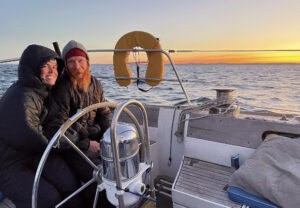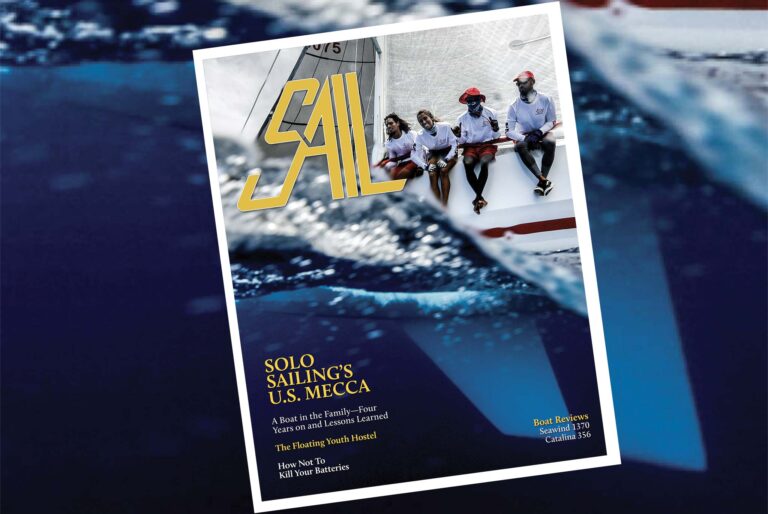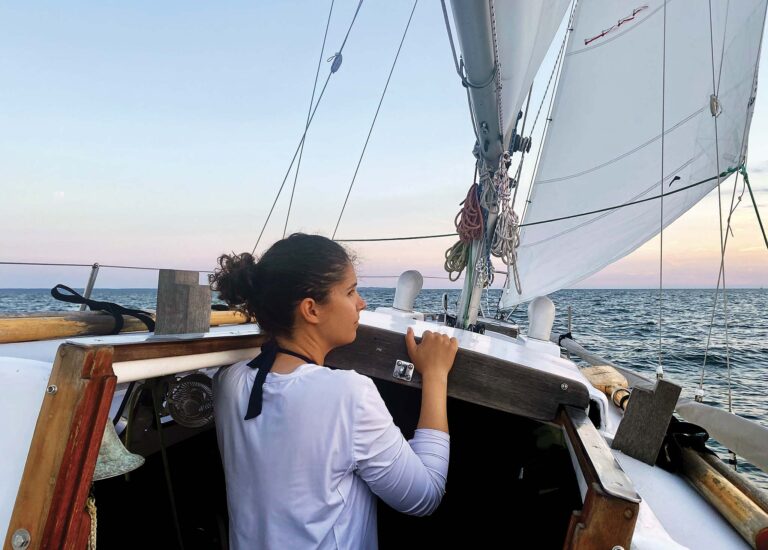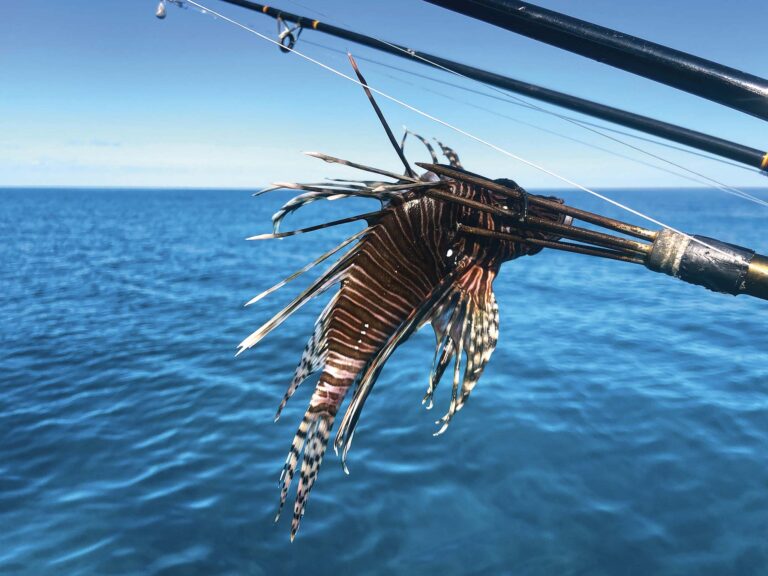
Last April, my wife, Marjorie, and I decided to take our Tartan 4100, Meri, north to Maryland from her winter home in Hobe Sound, Florida. This, in turn, meant deciding whether to stay in the “Ditch” for the duration or go offshore part of the way. Although we had both been small-boat sailors since childhood, we’d been relatively new to larger boats before purchasing our Tartan. I’d also had her delivered to Florida the previous fall, so this would be our first Intracoastal Waterway passage.
Meri has an air draft of 63ft 4in and her keel draws 5ft 4in, so going all the way on the ICW was certainly an option. We’d also made two crossings to the Bahamas and back that winter, which meant we now had some offshore experience as well. Still, we were not yet comfortable with making a long passage, so on this trip we decided to restrict ourselves to offshore jumps of less than 250 miles. Nine days into our trip, though, and having travelled two segments on the ICW and already on our second run offshore, we were fast coming to understand the relative merits of traveling inshore versus offshore for newer cruisers.
Up to that point we had taken the ICW from Hobe Sound, Florida, to the St. Mary’s inlet north of Jacksonville. From there we’d sailed offshore to Charleston, South Carolina, where we took a slip and stayed two nights, spending a day sightseeing and enjoying the Piccolo Spoleto arts festival. After that we were back on the ICW as far as Winyah Bay Inlet near Georgetown, South Carolina, where went outside again, after which we planned to duck back inside at Little River Inlet, just north of the Carolinas border.

Some people like to “stop and smell the roses” when traveling. For them, the ICW will hold a lot of appeal with its numerous small towns and other interesting places to stop along the way. I, on the other hand, am not such a person. When on a road trip I want to reach my destination as soon as comfortably possible. Still, even I found something magical about cruising up the ICW.
You can put in long days and make great time, for example, while at the same time getting up close and personal with your surroundings. Some sections of the ICW are well populated and more than once I had the impression we were traveling down an alleyway between houses in an upscale neighborhood. Other sections, though, seem very remote. When you have seen neither a house nor crab trap for an hour or two you start to get the impression of being deep in the wilderness.
It was often wonderful soaking up the scenery hour after hour, traveling slowly through the countryside, seeing all the interesting sights and watching as the character of the landscape evolved. The sense of traveling slowly is very different when you are inshore than when at sea, where you have no sense of the scale of your motion other than your boat’s wake and the progression of your charted position.
Of course, sailing offshore is wonderful as well, albeit in different ways. Not confined by a narrow channel, we were able to sail much more often, and the peacefulness of having tens of miles with no one around and the relative quiet of the wind and waves makes time go by quickly. The ocean has an immense, diverse beauty that often takes you by surprise. Marjorie and I do a lot of reading, knitting, laptop work and boat maintenance while sailing offshore, and it seems the most pleasant, non-distracting location for such things—at least for the person not at the helm, and sometimes even the helmsman too.

In fact, I drafted this article while sitting at the helm: the sound and motion of the waves and water combined with the infrequent need to look up to check the sails or scan the horizon allowed my mind to be both present in the moment and also accomplish something else. This is in contrast to the ICW, where manning the helm tends to be a full-time job.
We also found other direct comparisons and contrasts. For example, when offshore you are going to be offshore for some length of time, even if you don’t want to, due both to your distance from the coast and the 10- to 60-mile intervals between inlets. If you want to call it quits on the ICW, however, you can often find a place nearby to set the anchor or get a slip; though there are some sections where you might need to travel a number of miles to find a suitable anchorage or a marina.
Planning for going offshore or inshore along the ICW is different too, with differing considerations for weather, watches, fuel, depths, tides, currents and bridges.

Yet another consideration when going offshore is how the distance translates into statute miles on the ICW. Some inlets have long channels that you must respect to avoid shoals. Not only that, some of these channels angle in a direction opposite your intended travel.
Consider the ICW mile markers where you will leave and return to the ICW, the distance you must travel to reach the open ocean, the distance on the ocean to your inbound inlet, and the distance back into the ICW. In some cases, you will save a lot of time by going offshore. For example, sailing offshore from St. Mary’s to Charleston saves 90 miles. Other combinations of inlets, however, have an opposite effect: Little River to Masonboro in the Carolinas is only 57 miles by ICW, but would be about 85 miles traveling offshore. Similarly, from the ICW you must cover a good 15 miles (and negotiate a lock and a drawbridge) to get out through Florida’s Port Canaveral inlet to the open ocean.
Beyond that, the character of inshore versus offshore travel differs significantly. You will see a lot of wildlife on the ICW, but not much offshore. Inshore, you will be treated to an almost continual menagerie of birds, livestock, dolphins and maybe even manatee. We loved watching the fishing birds, especially the osprey and the brown pelicans. In addition to their fishing antics, pelicans seem to have a union contract for overseeing bridge fenders and day marks, so that it can be hard to tell who is watching whom when you pass. We knew there were dolphins in the ICW, but we had no idea there were so many! Watching a pod circling a roiling school of fish is absolutely fascinating.

That said, there is also some wildlife on the ICW that we very much enjoyed NOT encountering offshore—including flies, mosquitos and no-see-ums. In addition, whenever you do see wildlife offshore, it is a real treat. Off the Georgia coast, for example, a large pod of dolphins enthusiastically played in our bow wave, putting on quite a show. We also enjoyed fishing offshore, catching mahi-mahi and black-fin tuna. We never fish on the ICW, due to the traffic, narrow channels, unfamiliar waters and the need to buy fishing licenses.
So, with two different ways to travel north, which do we prefer? In the final analysis, we like having the option of doing both. On those days when the weather is unfavorable but not horrendous, we can make good miles and also have a good time on the ICW.
If on the other hand, a fair wind is forecast, the waves aren’t too tall and the rain will be light or less, we prefer offshore. The trip is long enough to afford plenty of opportunity to sample both!
Photos by Doug Weibell
April 2019









